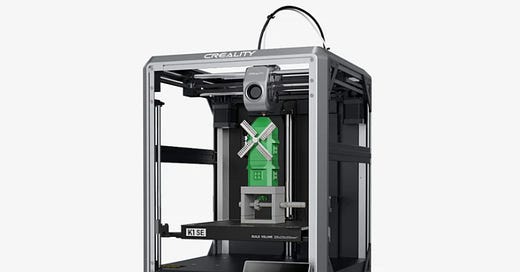Since its inception, Creality3D's philosophy has been simple: take the most popular and best 3D printer on the market and make a much cheaper copy. This was initially evident with the Prusa i3 (the CR series and the iconic Ender 3), then with Ultimaker (Ender 5), and now with Bambu Lab (the K series). This approach has positioned the company as one of the leaders in the global 3D printing market and has allowed it to earn quite respectable profits for the industry standards.
It's no surprise that the company remains steadfast in its strategy. Now, it is releasing a new 3D printer—the K1 SE, a truly inexpensive version of the Bambu Lab P1P.
For the past two years, Bambu Lab has been the undisputed leader in the desktop FDM/FFF 3D printer market. While its low price plays a significant role, its undeniable strengths are high-quality construction, numerous functionalities, and a comprehensive ecosystem. Initially, Bambu Lab stood out for its unprecedented printing speeds in filament-based 3D printing, but it also offers reliability, consistency, high print quality, user-friendliness through top-tier cloud solutions, and, more recently, the fantastically developing 3D print platform MakerWorld.
In response, Creality can at best replicate selected features (which isn't too difficult—3D printing isn't exactly a trip to Mars) and sell them even cheaper.
First, Creality introduced its budget version of the Bambu Lab X series with the Creality K1 priced at $559 (compared to Bambu Lab's $1,199). Now, they've unveiled the budget version of the P1P in the form of the Creality K1 SE, priced at $359 (while the Bambu Lab P1P costs $499).
So, what is the new 3D printer? Essentially, it's a K1 without the side panels but $200 cheaper. Both 3D printers share the same build volume of 22 x 22 x 25 cm and can reach identical maximum speeds of 600 mm/s with acceleration of 20,000 mm/s². They use the same extruder with a side spring and ball piston, as well as a triple-metal nozzle.
The K1 SE features only a metal cast frame—no side panels. The company also saved on fans; instead of three cooling fans, there's just one "dynamically balanced" fan. Additionally, it lacks a built-in AI-supported camera.
Creality3D continues to target customers who dislike overpaying and always opt for the cheapest option. However, at this price point, a $100 difference on 3D printers of this class starts to border on plain stinginess.
Source: www.creality.com





